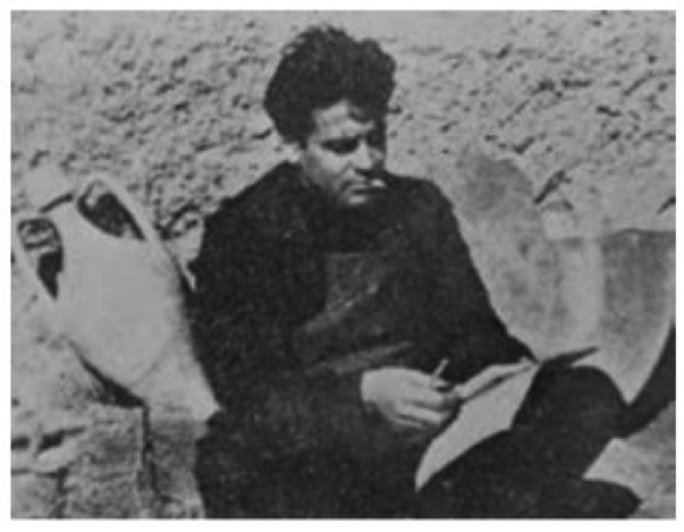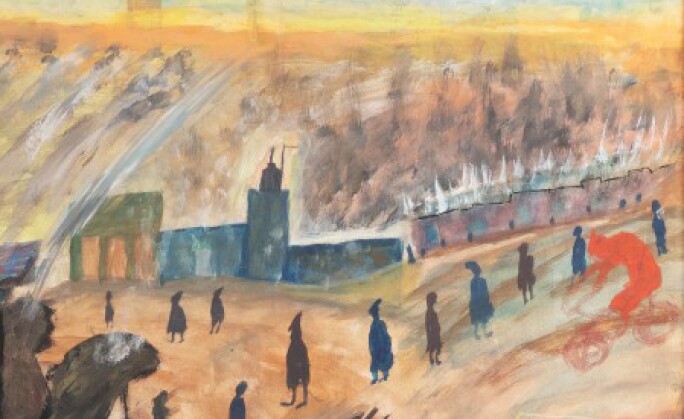
Source: Moulay Ahmed Drissi 1924-1973 L’invention d’une modernité pictural , Editions Marsam, 2016
The present work by modern Moroccan artist, Moulay Ahmed Drissi, is thought to be a depiction of the conflict that occurred in the city of Marrakech during the period in which the French colonialist and the Pasha, Thami El Glaoui worked to oust Sultan Mohammed V.
Sultan Mohammed V became a central figure in the Moroccan independence movement and eventually ruled as King of Morocco from 1957-1961. Painted in 1954, this work would have been produced in the year following the Sultan's exile from Morocco in 1953. Depicting the iconic Jamaa Fna Place, Marrakech’s main and most famous square, the present lot is recognized as one of Drissi’s most important and largest works.
Born in 1924, Drissi is credited as a father of Morocco’s modern visual arts movement. His repertoire of work, simple and sincere, paved the way forward for other notable Modernist painters like Mohamed Melehi and Mohamed Hamidi. Not only do his works document a country’s most transformative political years, but also a quieter, quotidian, vision of Morocco from days gone by. Sometimes whimsical and bearing elements of the surreal, Moulay Ahmed Drissi’s creations are known for capturing the soul and authenticity of his nation.
In his practice, Moulay Ahmed Drissi shys away from three-dimensionality and perspective, instead favoring flat minimalist compositions with pared down figures, usually simply dressed in their distinguishable djellabas with no facial features. Despite favoring the two-dimensional, Drissi still manages to present a clearly defined foreground, middleground and background. The present lot is an exceptional example of this.

Closer to the viewer, everyday lanes of tracks zoom across the canvas, followed by several rows of citizens wearing djellabas and soldiers holding weapons, and finally, further from the viewer, are trader’s tents and the walls surrounding the city or medina. In the distance, a minaret. Drissi often used walls or palatial buildings to give the illusion of a horizon line in his works, anchoring the composition.
Agitated, quick strokes and dark hues of brown and terracotta project an air of dissension throughout the work - this is further reinforced by the presence of armed forces- a common feature in this important artist’s oeuvre. Despite using a range of palates in his broader practice, many of Drissi’s more politically inspired pieces are executed using a muted palette.
Scenes such as the one shown in Jamaa Fna Place, fit into Drissi’s interest of capturing moments of political tension and confrontation. The work is not only emblematic of Moulay Ahmed Drissi’s practice but also holds immense value in its depiction of one of the most important times in Morocco’s history, capturing the emotion and energy of this important city at the height of its unrest.

Drissi began to paint seriously at a young age after an encounter with a visiting artist from Lausanne, who supplied him with materials. His early career brought him to Europe where he visited several cities, including Venice. His work had caught the eye of Peggy Guggenheim, who invited him to exhibit in Venice at the Peggy Guggenheim Collection in the mid-1950s. Moulay Ahmed Drissi’s work with Peggy placed him amongst the ranks of other significant artists with whom the famed art collector worked, including Jackson Pollock and Alexander Calder.
Moulay Ahmed Drissi’s work has been exhibited at the Alexandria Biennale in 1957 and the Paris Biennale in 1963, where he was included in a group of exhibitions celebrating modern Moroccan art. In 1960, he was the focus of a monograph organized by Gaston Diehl.
The artist settled in Paris in 1954, before moving back to Morocco in 1958, where he was receiving a significant amount of recognition. His work continues to be incredibly sought after by collectors across the globe, but particularly in his home country.
We are grateful to Abdeslam Boutaleb for their assistance in cataloguing this work.
Bibliography:
Editions Marson, Rachid Chraïbi, Moulay Ahmed Drissi 1924-1973 L’invention d’une modernité pictural